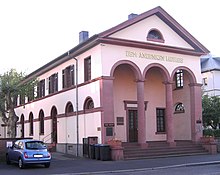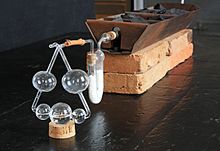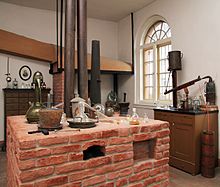Liebig Museum
The Liebig Museum is a natural science museum founded in Gießen in 1920 , which is dedicated to the chemist Justus Liebig . The building was originally erected as a guardhouse for a barracks and expanded by Liebig. It shows the working conditions and tools of that time in the former chemical institute , in which Liebig lived and researched during his time as a professor at Giessen University from 1824 to 1852.
The Liebig Museum is one of the most important chemistry museums in the world. In 2003 it was named a Historic Site of Chemistry by the Society of German Chemists (GDCh) .
History of the museum
In the years 1819–1821 the oldest part of the museum (rooms 1–5) was built as a guardhouse together with the adjacent barracks of a battalion of the 4th Grand Ducal Infantry Regiment. When there were disputes between students and the military, the soldiers were moved to Worms and the barracks became available to the university. From 1824 Liebig set up this guardhouse as a chemical laboratory . A few years later a second entrance area (6), the director's room (7a) and the private laboratory (7) were added. In 1839 the building was built in its current size and shape through the addition of the Pharmaceutical Laboratory (8), the Library (9), the Analytical Laboratory (10) and the Auditorium (11).
After Liebig left for Munich in 1852 and the establishment of a new chemical institute in Ludwigstrasse in 1888, the old institute served as accommodation for the physical chemists for a short time and was then given various other services.
In October 1910 the "Liebig Museum Society" was founded. The Secret Medical Councilor Emanuel August Merck was elected as 1st Chairman and the Secret Medical Councilor Robert Sommer was elected as 2nd Chairman . The museum was opened on March 26, 1920. At the end of 1944 an aerial bomb destroyed the old laboratory. After its repair, the museum was reopened to the public in the summer of 1952. The museum was completely redesigned in 1982 under the leadership of the then curator Siegfried Heilenz. In 2003 the exhibition was redesigned as part of the events for Justus Liebig's 200th birthday.
Spaces
Accessible are among others:
- the "old laboratory", which clearly shows the contrast to the premises built later and thus the further development of chemistry during Liebig's creative period,
- the weighing room with analytical scales made for Liebig by the Giessen master joiner Hoss,
- Liebig's private laboratory and office with his desk chair, about which a legend says that anyone who sits on this chair will one day become a scientist who will change the world,
- the pharmaceutical laboratory, in which pharmacist training took place at that time ,
- the library , including all of Liebig's works,
- the analytical laboratory with equipment for demonstrating elemental analysis and
- the auditorium where Liebig held his experimental lectures.
literature
- Literature on Liebig Museum in the Hessian Bibliography
- Siegfried Heilenz: The Liebig Museum in Giessen. (German / English or German / French), Gießen 1987, ISBN 3-922730-66-3 or ISBN 3-922730-82-5
- Hans R. Jenemann: The long-armed precision scales in the Liebig Museum in Giessen. Giessen 1988
- Georg Schwedt : Liebig and his students - the new school of chemistry . Springer Verlag, Berlin 2002, ISBN 3-540-43205-1
- Fritz Kröhnke, Willi Weis: Justus v. Liebig and the Giessen Liebig Museum. Brühlsche Universitätsdruckerei Gießen, 1964/1980
Web links
- Justus-Liebig Gesellschaft zu Gießen eV: The Liebig Museum: history, opening times
- State Office for Monument Preservation Hessen (Ed.): Liebigmuseum In: DenkXweb, online edition of cultural monuments in Hessen
- Deutsches Museum Munich: The Liebig Laboratory from 1842 . Extract from: Masterpieces from the Deutsches Museum Volume VI , Munich 2002, ISBN 3-924183-59-7
Individual evidence
- ^ Society of German Chemists : On the 200th birthday of Justus v. Liebig - Unveiling of a memorial plaque, honoring a chemical descendant ( memento from October 19, 2016 in the Internet Archive ), press release from May 12, 2003, accessed on July 31, 2012
Coordinates: 50 ° 34 ′ 51 ″ N , 8 ° 39 ′ 58.3 ″ E






